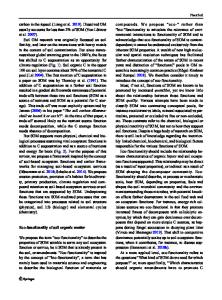Monitoring of DDT in Agricultural Soils under Organic Farming in Poland and the Risk of Crop Contamination
- PDF / 1,136,722 Bytes
- 14 Pages / 595.276 x 790.866 pts Page_size
- 17 Downloads / 257 Views
Monitoring of DDT in Agricultural Soils under Organic Farming in Poland and the Risk of Crop Contamination Eligio Malusá 1 Małgorzata Tartanus 1 Witold Danelski Joanna Kicińska 1 Ewa M. Furmanczyk 1 ●
●
1
●
Artur Miszczak
1
●
Ewelina Szustakowska1
●
●
1234567890();,:
1234567890();,:
Received: 1 May 2020 / Accepted: 30 July 2020 © The Author(s) 2020
Abstract The analysis of 142 agricultural soil samples collected in organic farms across Poland with the intent to evaluate the level of DDT contamination resulted in more than 80% of the soils containing DDT. The ΣDDT (sum of all metabolites and isomers) concentration ranged between 0.005 and 0.383 mg/kg ΣDDT, with an average value of 0.064 mg/kg ΣDDT. However, the majority of plant samples collected from the crops growing on the sampled soils did not contain detectable DDT residues. The high DDT pollution levels detected in samples from four voivodeships (regions) among those monitored have been hypothesised to be linked to horticultural productions occurring to the sampled fields and typical of those regions, particularly in big-sized farms, during the period of DDT application, as well as the number of pesticides landfills present in these voivodeships. The elaboration of the o,p′-DDT/p,p′-DDT and DDT/(DDE + DDD) ratios to appraise the source or the period of contamination suggested that the contamination originated from past use of DDT rather than from impurities of more recent applications of other formulated substances. Such outcome thus suggests that the risk of contamination of organic products is likely derived from general environmental pollution levels rather than from the use of unauthorised substances in organic farming productions. Data from a trial with artificial contamination of soils indicated that using the DDT/(DDE + DDD) ratio in the presence of a low level of contamination could be less reliable than in highly contaminated soils. Keywords Contamination source DDT metabolites ratio DDT monitoring Plant residues uptake Soil pollution ●
●
Introduction The extensive and widespread use of plant protection products (PPPs) in the management of agricultural crops has resulted in their increasing presence in agroecosystems, thereby raising environmental, health and food safety concerns. To reduce the negative impact of PPPs, the implementation of integrated pest management practices has been promoted since the 1950s (Boller et al. 2006) and is now compulsory in the entire European Union (EU). In parallel, the conversion to organic farming
Supplementary Information The online version of this article (https://doi.org/10.1007/s00267-020-01347-9) contains supplementary material, which is available to authorized users. * Eligio Malusá [email protected] 1
Research Institute of Horticulture, Skierniewice, Poland
●
●
pursues a limited use of PPPs, forbidding the application of all the synthetic ones (Matyjaszczyk 2018). However, the presence of residues in the soil deriving from previous, long-term applications of PPPs, particularly those hav
Data Loading...











